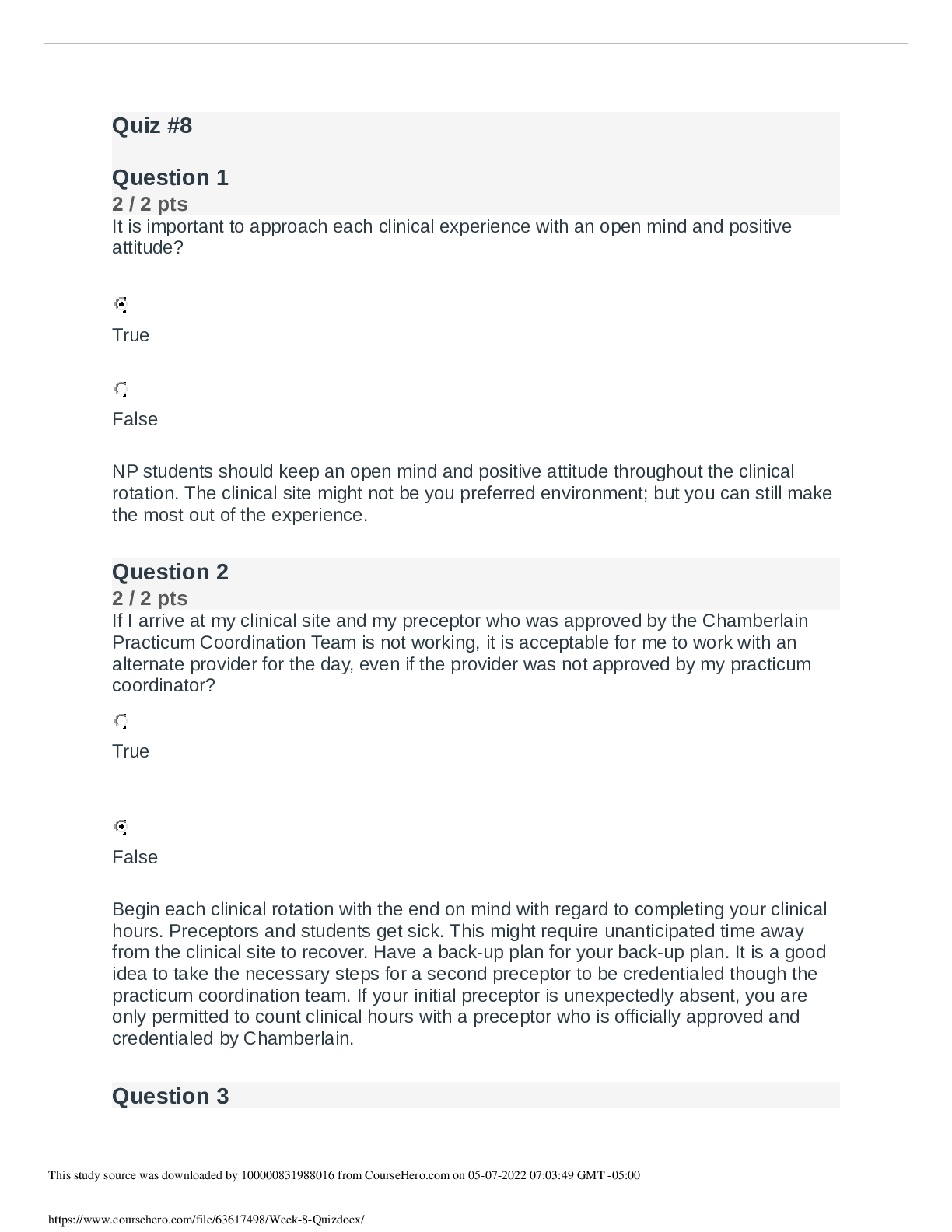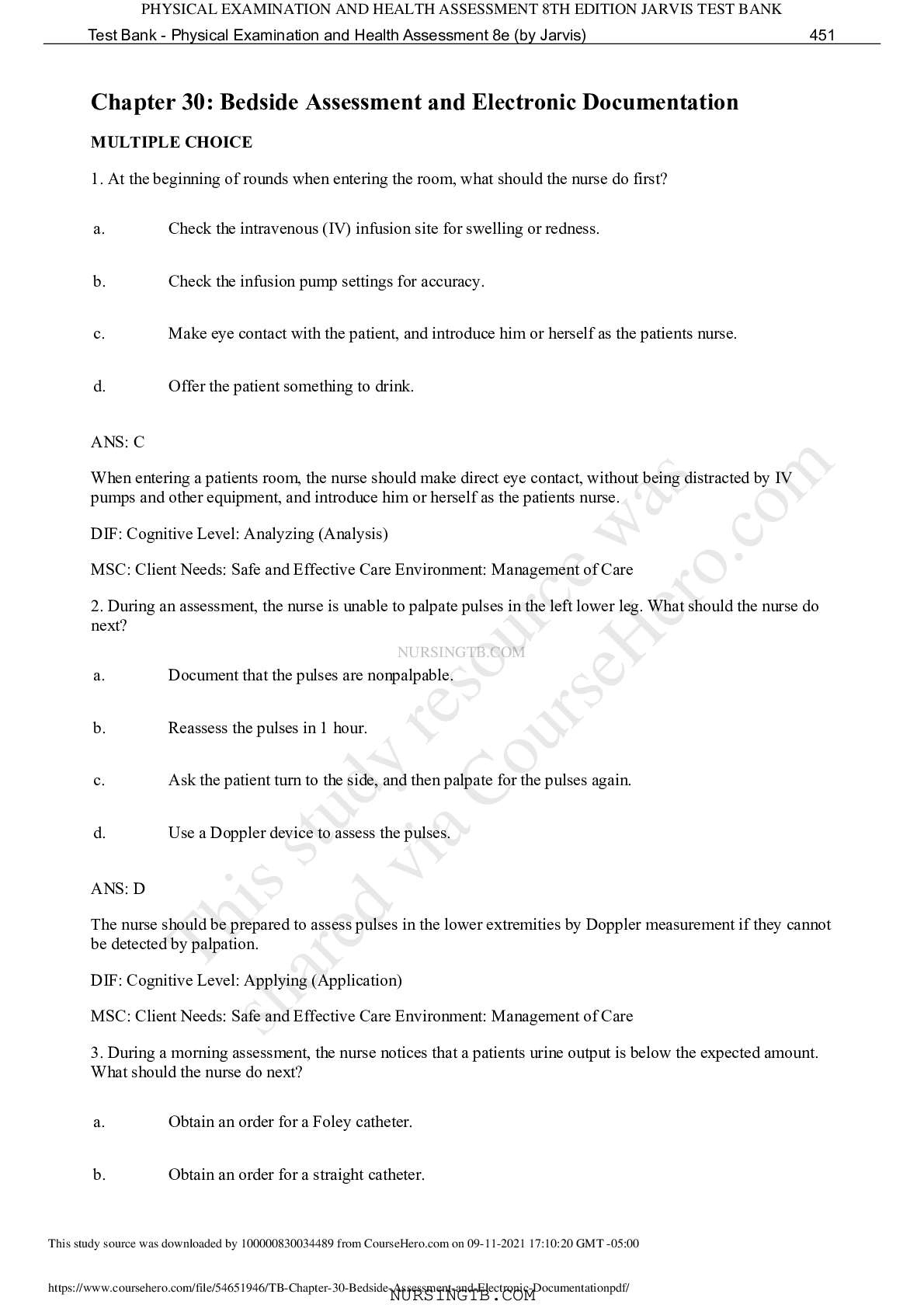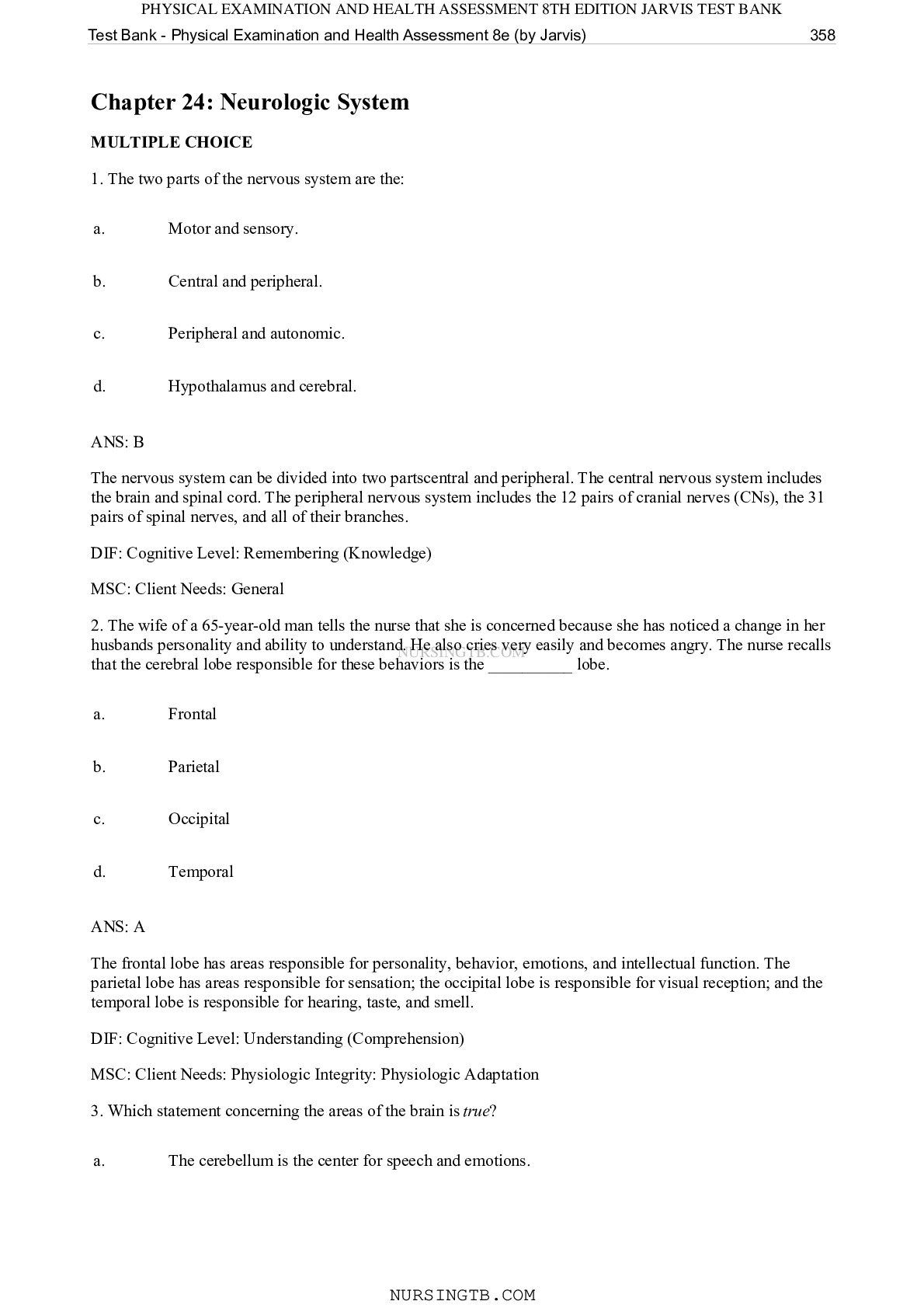*NURSING > QUESTIONS & ANSWERS > SOLVED!!! NR 509 COMPREHENSIVE REVIEW OF JARVIS 7TH EDITION CHAPTER 14 QUESTIONS (Head, Face, Neck a (All)
SOLVED!!! NR 509 COMPREHENSIVE REVIEW OF JARVIS 7TH EDITION CHAPTER 14 QUESTIONS (Head, Face, Neck and Regional Lymphatics: Physical Examination & Health Assessment)
Document Content and Description Below
SOLVED!!! NR 509 COMPREHENSIVE REVIEW OF JARVIS 7TH EDITION CHAPTER 14 QUESTIONS (Head, Face, Neck and Regional Lymphatics: Physical Examination & Health Assessment) ◇This material contains comprehe... nsive summary of information in the form of great test questions with descriptive answers helpful for exams study. Thorough Review of Jarvis 7th Edition Chapter 14 Questions. All the best Champions!!! _____ MULTIPLE CHOICE 1. A physician tells the nurse that a patients vertebra prominens is tender and asks the nurse to reevaluate the area in 1 hour. The area of the body the nurse will assess is: a. Just above the diaphragm. b. c. d. ANS: C The C7 vertebra has a long spinous process, called the vertebra prominens, which is palpable when the head is flexed. DIF: Cognitive Level: Applying (Application) MSC: Client Needs: Physiologic Integrity: Physiologic Adaptation 2. A mother brings her 2-month-old daughter in for an examination and says, My daughter rolled over against the wall, and now I have noticed that she has this spot that is soft on the top of her head. Is something terribly wrong? The nurses best response would be: NURSINGTB.COM a. b. c. d. ANS: D Membrane-covered soft spots allow for growth of the brain during the first year of life. They gradually ossify; the triangular-shaped posterior fontanel is closed by 1 to 2 months, and the diamond-shaped anterior fontanel closes between 9 months and 2 years. DIF: Cognitive Level: Applying (Application) MSC: Client Needs: Health Promotion and Maintenance 3. The nurse notices that a patients palpebral fissures are not symmetric. On examination, the nurse may find that damage has occurred to which cranial nerve (CN)? a. III Perhaps that could be a result of your dietary intake during pregnancy. Your baby may have craniosynostosis, a disease of the sutures of the brain. That soft spot may be an indication of cretinism or congenital hypothyroidism. That soft spot is normal, and actually allows for growth of the brain during the first year of your babys life. Just lateral to the knee cap. At the level of the C7 vertebra. At the level of the T11 vertebra. 176 NURSINGTB.COMPHYSICAL EXAMINATION AND HEALTH ASSESSMENT 8TH EDITION JARVIS TEST BANK Test Bank - Physical Examination and Health Assessment 8e (by Jarvis) 177 b. c. d. ANS: C Facial muscles are mediated by CN VII; asymmetry of palpebral fissures may be attributable to damage to CN VII (Bell palsy). DIF: Cognitive Level: Applying (Application) MSC: Client Needs: Physiologic Integrity: Physiologic Adaptation 4. A patient is unable to differentiate between sharp and dull stimulation to both sides of her face. The nurse suspects: a. Bell palsy. b. c. d. ANS: B Facial sensations of pain or touch are mediated by CN V, which is the trigeminal nerve. Bell palsy is associated with CN VII damage. Frostbite and scleroderma are not associated with this problem. DIF: Cognitive Level: Applying (Application) MSC: Client Needs: Physiologic Integrity: Physiologic Adaptation 5. When examining the face of a patient, the nurse is aware that the two pairs of salivary glands that are accessible to examination are the ___________ and ___________ glands. a. Occipital; submental b. c. d. Parotid; jugulodigastric Parotid; submandibular Submandibular; occipital ANS: C Two pairs of salivary glands accessible to examination on the face are the parotid glands, which are in the Damage to the trigeminal nerve. Frostbite with resultant paresthesia to the cheeks. NURSINGTB.COM Scleroderma. V VII VIII NURSINGTB.COMPHYSICAL EXAMINATION AND HEALTH ASSESSMENT 8TH EDITION JARVIS TEST BANK Test Bank - Physical Examination and Health Assessment 8e (by Jarvis) 178 cheeks over the mandible, anterior to and below the ear; and the submandibular glands, which are beneath the mandible at the angle of the jaw. The parotid glands are normally nonpalpable. DIF: Cognitive Level: Understanding (Comprehension) MSC: Client Needs: Safe and Effective Care Environment: Management of Care 6. A patient comes to the clinic complaining of neck and shoulder pain and is unable to turn her head. The nurse suspects damage to CN ______ and proceeds with the examination by _____________. a. XI; palpating the anterior and posterior triangles b. c. d. ANS: B The major neck muscles are the sternomastoid and the trapezius. They are innervated by CN XI, the spinal accessory. The innervated muscles assist with head rotation and head flexion, movement of the shoulders, and extension and turning of the head. DIF: Cognitive Level: Analyzing (Analysis) MSC: Client Needs: Safe and Effective Care Environment: Management of Care NURSINGTB.COM 7. When examining a patients CN function, the nurse remembers that the muscles in the neck that are innervated by CN XI are the: a. Sternomastoid and trapezius. b. c. d. ANS: A The major neck muscles are the sternomastoid and the trapezius. They are innervated by CN XI, the spinal accessory. DIF: Cognitive Level: Remembering (Knowledge) MSC: Client Needs: General 8. A patients laboratory data reveal an elevated thyroxine (T4) level. The nurse would proceed with an examination of the _____ gland. a. Thyroid Spinal accessory and omohyoid. Trapezius and sternomandibular. Sternomandibular and spinal accessory. XI; asking the patient to shrug her shoulders against resistance XII; percussing the sternomastoid and submandibular neck muscles XII; assessing for a positive Romberg sign NURSINGTB.COMPHYSICAL EXAMINATION AND HEALTH ASSESSMENT 8TH EDITION JARVIS TEST BANK Test Bank - Physical Examination and Health Assessment 8e (by Jarvis) 179 b. c. d. ANS: A The thyroid gland is a highly vascular endocrine gland that secretes T4 and triiodothyronine (T3). The other glands do not secrete T4. DIF: Cognitive Level: Understanding (Comprehension) MSC: Client Needs: Safe and Effective Care Environment: Management of Care 9. A patient says that she has recently noticed a lump in the front of her neck below her Adams apple that seems to be getting bigger. During the assessment, the finding that leads the nurse to suspect that this may not be a cancerous thyroid nodule is that the lump (nodule): a. b. c. d. ANS: B Painless, rapidly growing nodules may be cancerous, especially the appearance of a single nodule in a young person. However, cancerous nodules tend to be hard and fixed to surrounding structures, not mobile. DIF: Cognitive Level: Applying (Application) MSC: Client Needs: Physiologic Integrity: Physiologic Adaptation 10. The nurse notices that a patients submental lymph nodes are enlarged. In an effort to identify the cause of the node enlargement, the nurse would assess the patients: a. Infraclavicular area. b. c. d. ANS: D Supraclavicular area. Area distal to the enlarged node. Area proximal to the enlarged node. Is tender. Is mobile and not hard. Disappears when the patient smiles.NURSINGTB.COM Is hard and fixed to the surrounding structures. Parotid Adrenal Parathyroid NURSINGTB.COMPHYSICAL EXAMINATION AND HEALTH ASSESSMENT 8TH EDITION JARVIS TEST BANK Test Bank - Physical Examination and Health Assessment 8e (by Jarvis) 180 When nodes are abnormal, the nurse should check the area into which they drain for the source of the problem. The area proximal (upstream) to the location of the abnormal node should be explored. DIF: Cognitive Level: Analyzing (Analysis) MSC: Client Needs: Safe and Effective Care Environment: Management of Care 11. The nurse is aware that the four areas in the body where lymph nodes are accessible are the: a. Head, breasts, groin, and abdomen. b. c. d. ANS: D Nodes are located throughout the body, but they are accessible to examination only in four areas: head and neck, arms, inguinal region, and axillae. DIF: Cognitive Level: Remembering (Knowledge) MSC: Client Needs: Safe and Effective Care Environment: Management of Care 12. A mother brings her newborn in for an assessment and asks, Is there something wrong with my baby? His head seems so big. Which statement is true regarding the relative proportions of the head and trunk of the newborn? NURSINGTB.COM a. b. c. d. ANS: B The nurse recognizes that during the fetal period, head growth predominates. Head size is greater than chest circumference at birth, and the head size grows during childhood, reaching 90% of its final size when the child is age 6 years. DIF: Cognitive Level: Understanding (Comprehension) MSC: Client Needs: Health Promotion and Maintenance 13. A patient, an 85-year-old woman, is complaining about the fact that the bones in her face have become more noticeable. What explanation should the nurse give her? a. Diets low in protein and high in carbohydrates may cause enhanced facial bones. At birth, the head is one fifth the total length. Head circumference should be greater than chest circumference at birth. The head size reaches 90% of its final size when the child is 3 years old. When the anterior fontanel closes at 2 months, the head will be more proportioned to the body. Arms, breasts, inguinal area, and legs. Head and neck, arms, breasts, and axillae. Head and neck, arms, inguinal area, and axillae. NURSINGTB.COMPHYSICAL EXAMINATION AND HEALTH ASSESSMENT 8TH EDITION JARVIS TEST BANK Test Bank - Physical Examination and Health Assessment 8e (by Jarvis) 181 b. c. d. ANS: C The facial bones and orbits appear more prominent in the aging adult, and the facial skin sags, which is attributable to decreased elasticity, decreased subcutaneous fat, and decreased moisture in the skin. DIF: Cognitive Level: Understanding (Comprehension) MSC: Client Needs: Health Promotion and Maintenance 14. A patient reports excruciating headache pain on one side of his head, especially around his eye, forehead, and cheek that has lasted approximately to 2 hours, occurring once or twice each day. The nurse should suspect: a. b. c. d. ANS: B Cluster headaches produce pain around the eye, temple, forehead, and cheek and are unilateral and always on the same side of the head. They are excruciating and occur once or twice per day and last to 2 hours each. DIF: Cognitive Level: Applying (Application) MSC: Client Needs: Physiologic Integrity: Physiologic Adaptation 15. A patient complains that while studying for an examination he began to notice a severe headache in the frontotemporal area of his head that is throbbing and is somewhat relieved when he lies down. He tells the nurse that his mother also had these headaches. The nurse suspects that he may be suffering from: a. b. c. Hypertension. Cluster headaches. Tension headaches. Hypertension. Cluster headaches. Tension headaches. Migraine headaches. NURSINGTB.COM Bones can become more noticeable if the person does not use a dermatologically approved moisturizer. More noticeable facial bones are probably due to a combination of factors related to aging, such as decreased elasticity, subcutaneous fat, and moisture in her skin. Facial skin becomes more elastic with age. This increased elasticity causes the skin to be more taught, drawing attention to the facial bones. NURSINGTB.COMPHYSICAL EXAMINATION AND HEALTH ASSESSMENT 8TH EDITION JARVIS TEST BANK Test Bank - Physical Examination and Health Assessment 8e (by Jarvis) d. ANS: D Migraine headaches tend to be supraorbital, retroorbital, or frontotemporal with a throbbing quality. They are severe in quality and are relieved by lying down. Migraines are associated with a family history of migraine headaches. DIF: Cognitive Level: Applying (Application) MSC: Client Needs: Physiologic Integrity: Physiologic Adaptation 16. A 19-year-old college student is brought to the emergency department with a severe headache he describes as, Like nothing Ive ever had before. His temperature is 40 C, and he has a stiff neck. The nurse looks for other signs and symptoms of which problem? a. b. c. d. ANS: D NURSINGTB.COM The acute onset of neck stiffness and pain along with headache and fever occurs with meningeal inflammation. A severe headache in an adult or child who has never had it before is a red flag. Head injury and cluster or migraine headaches are not associated with a fever or stiff neck. DIF: Cognitive Level: Analyzing (Analysis) MSC: Client Needs: Physiologic Integrity: Physiologic Adaptation 17. During a well-baby checkup, the nurse notices that a 1-week-old infants face looks small compared with his cranium, which seems enlarged. On further examination, the nurse also notices dilated scalp veins and downcast or setting sun eyes. The nurse suspects which condition [Show More]
Last updated: 1 year ago
Preview 1 out of 18 pages

Buy this document to get the full access instantly
Instant Download Access after purchase
Add to cartInstant download
We Accept:

Reviews( 0 )
$15.00
Document information
Connected school, study & course
About the document
Uploaded On
Sep 13, 2021
Number of pages
18
Written in
Additional information
This document has been written for:
Uploaded
Sep 13, 2021
Downloads
0
Views
47




.png)
.png)
.png)
.png)

.png)





.png)

.png)



